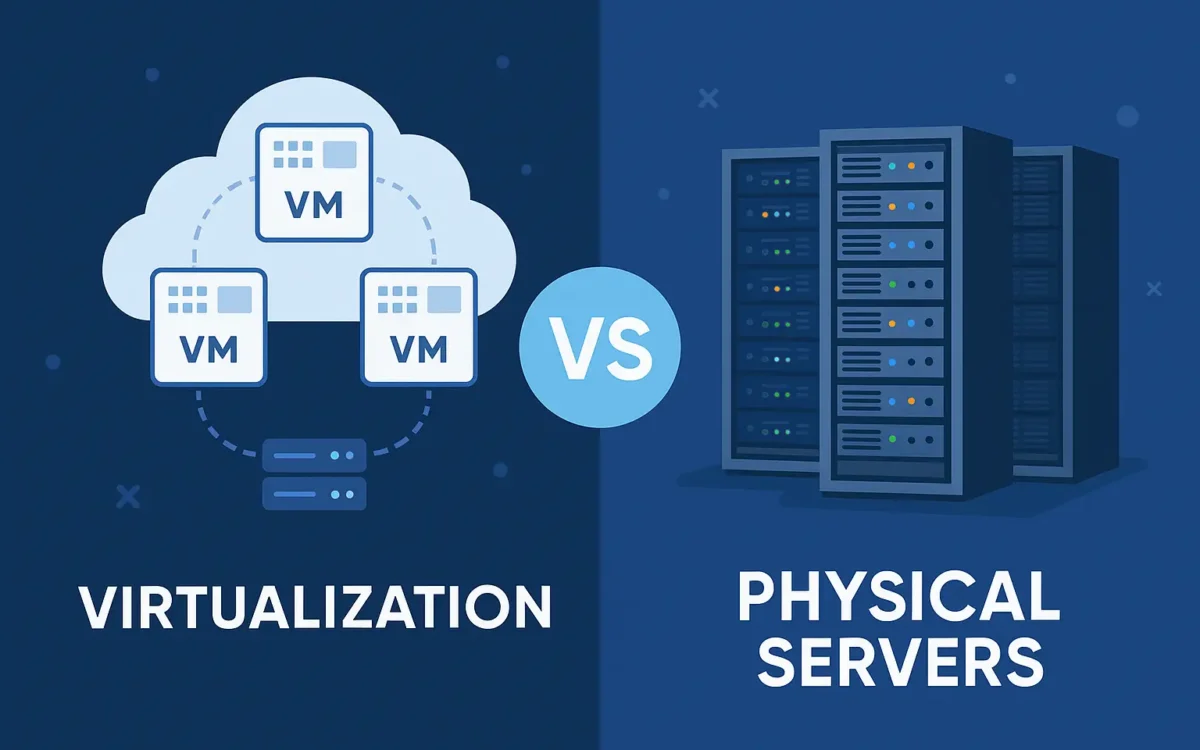In this hectic IT world, the proper choice of infrastructure is the key to your project or business success. You’re adding a new server environment, updating your existing systems, or constructing a test lab in your house, and one giant decision seems to hold you back from taking the next step: Virtualization vs Physical Servers?
We’ll examine both choices in-depth and help you decide which setup would be best for you.
What Are Physical Servers?
A physical server is a hardware device that is committed to hosting one operating system and executing focused tasks or services. Think of it as a powerful single-purpose machine—a great deal like an ordinary desktop but a lot more influential and specialized for business settings.
Advantages:
- Full access to hardware resources
- Predictable performance
- Ideal for hardware-dependent applications
Disadvantages:
- High upfront costs
- Limited scalability
- More physical space and maintenance required
What Is Virtualization?
Virtualization is a process of running numerous virtual machines (VMs) from a single physical server through the implementation of a hypervisor like VMware ESXi, Microsoft Hyper-V, or Proxmox. The VMs run autonomously, each with its own operating system, memory, and disk space—albeit on the same hardware.
Advantages:
- Better resource utilization
- Easier backups and snapshots
- Faster provisioning and scalability
- Cost-effective in the long run
Disadvantages:
- Requires skilled setup and management
- Performance can vary under heavy loads
- Some applications may not be virtualization-friendly
When to Choose Virtualization
- You’re working with multiple environments (test, staging, production)
- You want faster recovery with snapshots and replication
- You’re aiming to reduce hardware footprint
- You need flexibility in deploying and scaling services
When to Choose Physical Servers
- You’re dealing with resource-intensive applications
- You want dedicated performance for databases or large workloads
- Your infrastructure must meet strict security or compliance standards
- You prefer hardware-level control or need specific components (e.g., GPUs)
Virtualization vs Physical Servers
| Feature / Criteria | Virtualization | Physical Servers |
|---|---|---|
| Cost | Lower hardware cost due to multiple VMs on one host | Higher initial investment for each dedicated server |
| Scalability | Highly scalable — quickly add/remove VMs | Limited by physical space and hardware upgrades |
| Performance | Slight overhead due to hypervisor | Native hardware access = maximum performance |
| Deployment Time | Fast provisioning using templates or automation | Slower — manual OS and app installation |
| Hardware Utilization | Efficient resource usage through VM sharing | Often underutilized — one workload per server |
| Maintenance | Easier with centralized management tools | Requires individual server access and updates |
| Energy Consumption | Lower (fewer machines needed) | Higher — more physical units consume more power |
| Disaster Recovery | Easier — VMs can be backed up and restored quickly | Slower — recovery needs full system rebuild |
| Flexibility | High — migrate VMs across hosts with ease | Low — hardware-bound, not easily transferable |
| Security | Risk of hypervisor attacks, but isolated environments | Strong physical isolation, but more hardware attack risk |
| Use Case Suitability | Ideal for dynamic, multi-tenant, or dev/test systems | Better for performance-critical or legacy apps |
Virtualization vs Physical Servers Final
There isn’t an IT infrastructure for all. Virtualization is scalable, cost-effective, and agile, so it’s a fine choice for the majority of today’s environments. Physical servers are a fine choice, though, when top-notch performance, rock-solid stability, and complete control of the hardware is the ultimate priority.
Consider your objective, workload, and next step—and choose the optimum infrastructure for you.

